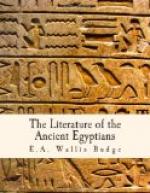The substances used by the Egyptians for writing upon were very numerous, but the commonest were stone of various kinds, wood, skin, and papyrus. The earliest writings were probably traced upon these substances with some fluid, coloured black or red, which served as ink. When the Egyptians became acquainted with the use of the metals they began to cut their writings in stone. The text of one of the oldest chapters of the Book of the Dead (LXIV) is said in the Rubric to the chapter to have been “found” cut upon a block of “alabaster of the south” during the reign of Menkaura, a king of the fourth dynasty, about 3700 B.C. As time went on and men wanted to write long texts or inscriptions, they made great use of wood as a writing material, partly on account of the labour and expense of cutting in stone. In the British Museum many wooden coffins may be seen with their insides covered with religious texts, which were written with ink as on paper. Sheepskin, or goatskin, was used as a writing material, but its use was never general; ancient Egyptian documents written on skin or, as we should say, on parchment, are very few. At a very early period the Egyptians learned how to make a sort of paper, which is now universally known by the name of “papyrus.” When they made this discovery cannot be said, but the hieroglyphic inscriptions of the early dynasties contain the picture of a roll of papyrus, and the antiquity of the use of papyrus must therefore be very great. Among the oldest dated examples of inscribed papyrus may be noted some accounts which were written in the reign of King Assa (fourth dynasty, 3400 B.C.), and which were found at Sakkarah, about 20 miles to the south of Cairo.
Papyrus was made from the papyrus plant that grew and flourished in the swamps and marshes of Lower Egypt, and in the shallow pools that were formed by the annual Nile flood. It no longer grows in Egypt, but it is found in the swamps of the Egyptian Sudan, where it grows sometimes to a height of 25 feet. The roots and the stem, which is often thicker than a man’s arm, are used as fuel, and the head, which is large and rounded, is in some districts boiled and eaten as a vegetable. The Egyptian variety of the papyrus plant was smaller than that found in the Sudan, and the Egyptians made their paper from it by cutting the inner part of the stem into thin strips, the width of which depended upon the thickness of the stem; the length of these varied, of course, with the length of the stem. To make a sheet of papyrus several of these strips were laid side by side lengthwise, and several others were laid over them crosswise. Thus each sheet of papyrus contained two layers, which were joined together by means of glue and water or gum. Pliny, a Roman writer, states (Bohn’s edition, vol. iii. p. 189) that Nile water, which, when in a muddy state, has the peculiar qualities of glue, was used in fastening the two layers of strips together, but traces of gum




